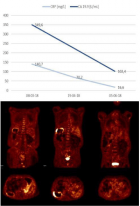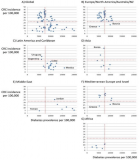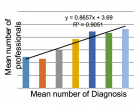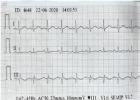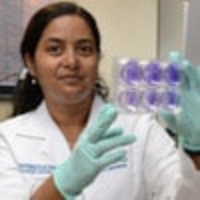Abstract
Research Article
Gynaecological malignancies after breast cancer diagnosis: A population-based study
Maria Pilar Barretina-Ginesta, Jaume Galceran*, Helena Pla, Cristina Meléndez, Anna Carbo Bague, Alberto Ameijide, Marià Carulla, Jordi Barretina, Angel Izquierdo and Rafael Marcos-Gragera
Published: 31 October, 2019 | Volume 2 - Issue 2 | Pages: 113-118
Background: Breast cancer (BC) is one of the most prevalent malignancies. BC survivors have higher risk of second primary cancers than the general population. There is an increased interest in BC survivor management, including the prevention of these second cancers. The aim of this study was to assess the risk of gynaecological malignancy (GM) as second neoplasm among BC patients in our population.
Methods: Patients with invasive BC diagnosed from 1980 to 2014 included in the Girona Cancer Registry were included. The incidence of second GM in these patients was compared to those in the general population. Second primary cancer was stated as a tumour diagnosed after 2 months from the BC diagnosis. Standardized incidence ratios (SIR) and absolute excess of risk (AER) were calculated.
Results: 9,717 patients were diagnosed with invasive BC during this period, with a median age at diagnosis of 61 years, and a median follow-up of 7.9 years. 117 of them developed a second GM. By tumour type, the only statistically significant higher SIR was observed for corpus uteri cancer (SIR:2.28 95% CI 1.82-2.83; AER:6.43 95% CI 4.13-9.14). After reviewing the histology of the corpus uteri cancer cases, we found that 71.4% were type I (endometrioid adenocarcinoma), 15.5% type II (serous adenocarcinomas and clear cell carcinomas), 10.7% carcinosarcomas, 2.4% sarcomas and there were no unspecified malignant neoplasms.
Conclusion: BC survivors have an increased risk of corpus uteri cancer, with an increase in unfavourable histologies compared to the general population. Lifelong primary and secondary prevention interventions should be recommended for these patients.
Read Full Article HTML DOI: 10.29328/journal.cjog.1001031 Cite this Article Read Full Article PDF
Keywords:
Breast cancer; Gynaecological malignancies; Second primary cancer; Standardized incidence ratio
References
- Bray F, Ferlay J, Soerjomataram I, Siegel RL, Torre LA, et al. Global Cancer Statistics 2018: GLOBOCAN Estimates of Incidence and Mortality Worldwide for 36 Cancers in 185 Countries. CA Cancer J Clin. 2018; 68: 394–424. PubMed: https://www.ncbi.nlm.nih.gov/pubmed/30207593
- Clèries R, Ameijide A, Marcos-Gragera R, Pareja L, Carulla M, et al. Predicting the cancer burden in Catalonia between 2015 and 2025: the challenge of cancer management in the elderly. Clin Transl Oncol. 2018; 20: 647–657. PubMed: https://www.ncbi.nlm.nih.gov/pubmed/29027110
- Allemani C, Matsuda T, Di Carlo V, Harewood R, Matz M, et al. Global surveillance of trends in cancer survival 2000-14 (CONCORD-3): analysis of individual records for 37 513 025 patients diagnosed with one of 18 cancers from 322 population-based registries in 71 countries. Lancet (London, England). 2018; 391: 1023–1075. PubMed: https://www.ncbi.nlm.nih.gov/pubmed/29395269
- Pollán M, Pastor-Barriuso R, Ardanaz E, Argüelles M, Martos C, et al. Recent changes in breast cancer incidence in Spain, 1980-2004. J Natl Cancer Inst. 2009; 101: 1584–1591. PubMed: https://www.ncbi.nlm.nih.gov/pubmed/19861303
- Matesich SMA, Shapiro CL. Second cancers after breast cancer treatment. Semin Oncol. 2003; 30: 740–748. PubMed: https://www.ncbi.nlm.nih.gov/pubmed/14663775
- Liu J, Jiang W, Mao K, An Y, Su F, et al. Elevated risks of subsequent endometrial cancer development among breast cancer survivors with different hormone receptor status: a SEER analysis. Breast Cancer Res Treat. 2015; 150: 439–445. PubMed: https://www.ncbi.nlm.nih.gov/pubmed/25764167
- Demark-Wahnefried W, Aziz NM, Rowland JH, Pinto BM. Riding the crest of the teachable moment: Promoting long-term health after the diagnosis of cancer. J Clin Oncol. 2005; 23: 5814–5830. PubMed: https://www.ncbi.nlm.nih.gov/pubmed/16043830
- Suris-Swartz PJ, Schildkraut JM, Vine MF, Hertz-Picciotto I. Age at diagnosis and multiple primary cancers of the breast and ovary. Breast Cancer Res Treat. 1996; 41: 21–29. PubMed: https://www.ncbi.nlm.nih.gov/pubmed/8932873
- Stratton JF, Gayther SA, Russell P, Dearden J, Gore M, et al. Contribution of BRCA1 mutations to ovarian cancer. N Engl J Med. 1997; 336: 1125–1130. PubMed: https://www.ncbi.nlm.nih.gov/pubmed/9099656
- Nagy E, Gajjar KB, Patel II, Taylor S, Martin-Hirsch PL, et al. MGMT promoter hypermethylation and K-RAS, PTEN and TP53 mutations in tamoxifen-exposed and non-exposed endometrial cancer cases. Br J Cancer. 2014; 110: 2874–2880. PubMed: https://www.ncbi.nlm.nih.gov/pubmed/24853176
- Mellemkjær L, Friis S, Olsen JH, Scélo G, Hemminki K, et al. Risk of second cancer among women with breast cancer. Int J Cancer. 2006; 118: 2285–2292. PubMed: https://www.ncbi.nlm.nih.gov/pubmed/16342146
- Volk N, Pompe-Kirn V. Second primary cancers in breast cancer patients in Slovenia. Cancer Causes Control. 1997; 8: 764–770. PubMed: https://www.ncbi.nlm.nih.gov/pubmed/9328199
- Harvey EB, Brinton LA. Second cancer following cancer of the breast in Connecticut, 1935-82. Natl Cancer Inst Monogr. 1985; 68: 99–112. PubMed: https://www.ncbi.nlm.nih.gov/pubmed/4088315
- Soerjomataram I, Louwman WJ, De Vries E, Lemmens VEPP, Klokman WJ, et al. Primary malignancy after primary female breast cancer in the south of the Netherlands, 1972-2001. Breast Cancer Res Treat. 2005; 93: 91–95. PubMed: https://www.ncbi.nlm.nih.gov/pubmed/16184464
- Gulhan I, Eser S, Yakut C, Bige O, Ilhan E, et al. Second primary gynecologic cancers after breast cancer in Turkish women. Int J Gynecol Cancer. 2009; 19: 648–650. PubMed: https://www.ncbi.nlm.nih.gov/pubmed/19509564
- Molina-Montes E, Pollán M, Payer T, Molina E, Dávila-Arias C, et al. Risk of second primary cancer among women with breast cancer: A population-based study in Granada (Spain). Gynecol Oncol. 2013; 130: 340–345. PubMed: https://www.ncbi.nlm.nih.gov/pubmed/23648471
- Jones ME, van Leeuwen FE, Hoogendoorn WE, Mourits MJE, Hollema H, et al. Endometrial cancer survival after breast cancer in relation to tamoxifen treatment: Pooled results from three countries. Breast Cancer Res. 2012; 14: R91. PubMed: https://www.ncbi.nlm.nih.gov/pubmed/22691381
- Hall HI, Jamison P, Weir HK. Second primary ovarian cancer among women diagnosed previously with cancer. Cancer Epidemiol Biomarkers Prev. 2001; 10: 995–999. PubMed: https://www.ncbi.nlm.nih.gov/pubmed/11535553
- Setiawan VW, Yang HP, Pike MC, McCann SE, Yu H, et al. Type I and II endometrial cancers: Have they different risk factors? J Clin Oncol. 2013; 31: 2607–2618. PubMed: https://www.ncbi.nlm.nih.gov/pubmed/23733771
- Dong C, Chen L. Second malignancies after breast cancer: The impact of adjuvant therapy. Mol Clin Oncol. 2014; 2: 331–336. PubMed: https://www.ncbi.nlm.nih.gov/pmc/articles/PMC3999127/
- Levi F, Randimbison L, Te VC, La Vecchia C. Prognosis of bilateral synchronous breast cancer in Vaud, Switzerland. Breast. 2003; 12: 89–91. PubMed: https://www.ncbi.nlm.nih.gov/pubmed/14659336
- Ngô C, Brugier C, Plancher C, De La Rochefordière A, Alran S, et al. Clinico-pathology and prognosis of endometrial cancer in patients previously treated for breast cancer, with or without tamoxifen: A comparative study in 363 patients. Eur J Surg Oncol. 2014; 40: 1237–1244. PubMed: https://www.ncbi.nlm.nih.gov/pubmed/25086993
- Cohen I. Endometrial pathologies associated with postmenopausal tamoxifen treatment. Gynecol Oncol. 2004; 94: 256–266. PubMed: https://www.ncbi.nlm.nih.gov/pubmed/15297160
- Davies C, Pan H, Godwin J, Gray R, Arriagada R, et al. Long-term effects of continuing adjuvant tamoxifen to 10 years versus stopping at 5 years after diagnosis of oestrogen receptor-positive breast cancer: ATLAS, a randomised trial. Lancet. 2013; 381: 805–816. PubMed: https://www.ncbi.nlm.nih.gov/pubmed/23219286
- Van Leeuwen FE, Benraadt J, Coebergh JW, Kiemeney LA, Gimbrere CH, et al. Risk of endometrial cancer after tamoxifen treatment of breast cancer. Lancet. 1994; 343: 448–452. PubMed: https://www.ncbi.nlm.nih.gov/pubmed/7905955
- Salani R, Andersen BL. Gynecologic care for breast cancer survivors: Assisting in the transition to wellness. Am J Obstet Gynecol. 2012; 206: 390–397. PubMed: https://www.ncbi.nlm.nih.gov/pubmed/22177185
- Wickerham DL, Fisher B, Wolmark N, Bryant J, Costantino J, et al. Association of tamoxifen and uterine sarcoma. J Clin Oncol. 2002; 20: 2758–2760. PubMed: https://www.ncbi.nlm.nih.gov/pubmed/12039943
- Magriples U, Naftolin F, Schwartz PE, Carcangiu ML. High-grade endometrial carcinoma in tamoxifen-treated breast cancer patients. J Clin Oncol. 1993; 11: 485–490. PubMed: https://www.ncbi.nlm.nih.gov/pubmed/8383191
- Swerdlow AJ, Jones ME. Tamoxifen treatment for breast cancer and risk of endometrial cancer: a case-control study. J Natl Cancer Inst. 2005; 97: 375–384. PubMed: https://www.ncbi.nlm.nih.gov/pubmed/15741574
- Ascunze Elizaga N, González Enríquez J, González Navarro A, Herranz Fernández C, Marqués Bravo A, et al. Criterios generales y recomendaciones para la elaboracion de programas de deteccion precoz de cáncer de mama y cáncer de cérvix uterino en España. Rev San Hig Púb. 1993; 67: 23–37.
Similar Articles
-
Gynaecological malignancies after breast cancer diagnosis: A population-based studyMaria Pilar Barretina-Ginesta,Jaume Galceran*,Helena Pla,Cristina Meléndez,Anna Carbo Bague,Alberto Ameijide,Marià Carulla,Jordi Barretina,Angel Izquierdo,Rafael Marcos-Gragera. Gynaecological malignancies after breast cancer diagnosis: A population-based study. . 2019 doi: 10.29328/journal.cjog.1001031; 2: 113-118
-
Triple negative breast cancer: Early stages management and evolution, a two years experience at the department of breast cancer of CHSFBouzid Nassima,Darido Jessie*,Diari Jed,Dussour Chloe,Ezenfis Joel,Cahn Virginie,Guekeu Steven,Rigonnot Luc. Triple negative breast cancer: Early stages management and evolution, a two years experience at the department of breast cancer of CHSF. . 2020 doi: 10.29328/journal.cjog.1001052; 3: 065-078
-
Three visionaries for HRTJoseph Loze Onwude*. Three visionaries for HRT. . 2021 doi: 10.29328/journal.cjog.1001077; 4: 007-009
-
Assessment of knowledge on breast self-examination among female adolescent: a cross-sectional studyPooja Prakash,Shanti Khadka,Muna Silwal,Ayush Chandra*. Assessment of knowledge on breast self-examination among female adolescent: a cross-sectional study. . 2022 doi: 10.29328/journal.cjog.1001104; 5: 036-041
Recently Viewed
-
A Update on Brachytherapy for Cervical Cancer: A ReviewArjun Moorthy,Ayan Issac,Ngoc-Anh Le,Kavin Mutyala*,Bhuvi Mamtani,Shyamal Patel,Lyndsay Willmott. A Update on Brachytherapy for Cervical Cancer: A Review. Clin J Obstet Gynecol. 2025: doi: 10.29328/journal.cjog.1001195; 8: 085-091
-
Misoprostol Usage in the Kingdom of Bahrain: A Retrospective StudyMaryam Alsalem*,Hosni Malas,Gulmeen Raza,Rehab Ismael. Misoprostol Usage in the Kingdom of Bahrain: A Retrospective Study. Clin J Obstet Gynecol. 2025: doi: 10.29328/journal.cjog.1001196; 8: 092-095
-
Fairness at a Cost: The Hidden Dangers of Steroid-Based Skin LightenersManahil Mubeen*,Wania Bint-e-Shahzad,Laiba Azeem,Iflah Noor. Fairness at a Cost: The Hidden Dangers of Steroid-Based Skin Lighteners. J Community Med Health Solut. 2025: doi: 10.29328/journal.jcmhs.1001062; 6: 077-079
-
Excipients and Vehicles in Galenic Practice: Considerations for Neonatology and Pediatrics: An Overview and Results of a Practical ExperienceLuisetto M*,Almukthar N,Edbey K,Hamid GA,Mashori GR,Cabianca L,Ferraioulo A,Fiazza C,Latyshev OY. Excipients and Vehicles in Galenic Practice: Considerations for Neonatology and Pediatrics: An Overview and Results of a Practical Experience. J Adv Pediatr Child Health. 2025: doi: 10.29328/journal.japch.1001075; 8: 023-026
-
Efficacy and Safety of Punch Elevation Combined with Dermapen in Treating Boxcar Post-acne Scars: A Paired Comparison Study in SyriaSajeda Alnabelsi*,Suzan Qattini. Efficacy and Safety of Punch Elevation Combined with Dermapen in Treating Boxcar Post-acne Scars: A Paired Comparison Study in Syria. Ann Dermatol Res. 2025: doi: 10.29328/journal.adr.1001037; 9: 008-012
Most Viewed
-
Feasibility study of magnetic sensing for detecting single-neuron action potentialsDenis Tonini,Kai Wu,Renata Saha,Jian-Ping Wang*. Feasibility study of magnetic sensing for detecting single-neuron action potentials. Ann Biomed Sci Eng. 2022 doi: 10.29328/journal.abse.1001018; 6: 019-029
-
Evaluation of In vitro and Ex vivo Models for Studying the Effectiveness of Vaginal Drug Systems in Controlling Microbe Infections: A Systematic ReviewMohammad Hossein Karami*, Majid Abdouss*, Mandana Karami. Evaluation of In vitro and Ex vivo Models for Studying the Effectiveness of Vaginal Drug Systems in Controlling Microbe Infections: A Systematic Review. Clin J Obstet Gynecol. 2023 doi: 10.29328/journal.cjog.1001151; 6: 201-215
-
Causal Link between Human Blood Metabolites and Asthma: An Investigation Using Mendelian RandomizationYong-Qing Zhu, Xiao-Yan Meng, Jing-Hua Yang*. Causal Link between Human Blood Metabolites and Asthma: An Investigation Using Mendelian Randomization. Arch Asthma Allergy Immunol. 2023 doi: 10.29328/journal.aaai.1001032; 7: 012-022
-
An algorithm to safely manage oral food challenge in an office-based setting for children with multiple food allergiesNathalie Cottel,Aïcha Dieme,Véronique Orcel,Yannick Chantran,Mélisande Bourgoin-Heck,Jocelyne Just. An algorithm to safely manage oral food challenge in an office-based setting for children with multiple food allergies. Arch Asthma Allergy Immunol. 2021 doi: 10.29328/journal.aaai.1001027; 5: 030-037
-
Impact of Latex Sensitization on Asthma and Rhinitis Progression: A Study at Abidjan-Cocody University Hospital - Côte d’Ivoire (Progression of Asthma and Rhinitis related to Latex Sensitization)Dasse Sery Romuald*, KL Siransy, N Koffi, RO Yeboah, EK Nguessan, HA Adou, VP Goran-Kouacou, AU Assi, JY Seri, S Moussa, D Oura, CL Memel, H Koya, E Atoukoula. Impact of Latex Sensitization on Asthma and Rhinitis Progression: A Study at Abidjan-Cocody University Hospital - Côte d’Ivoire (Progression of Asthma and Rhinitis related to Latex Sensitization). Arch Asthma Allergy Immunol. 2024 doi: 10.29328/journal.aaai.1001035; 8: 007-012

If you are already a member of our network and need to keep track of any developments regarding a question you have already submitted, click "take me to my Query."






